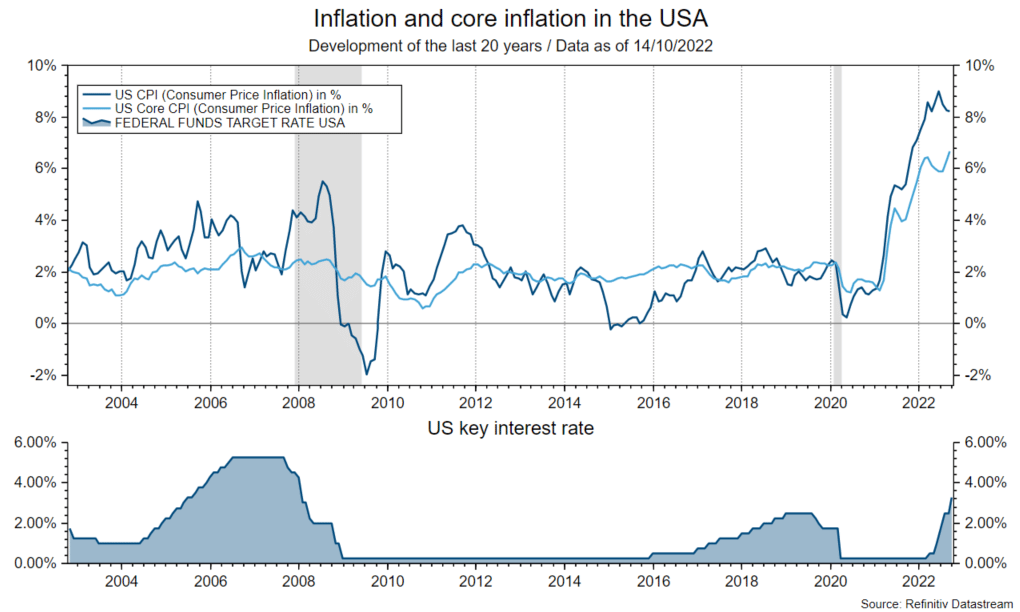Even though inflation rates have been falling significantly at monthly intervals since July, the inflation problem is not yet over. Central banks are showing a strong commitment to maintaining the basic monetary policy stance hawkish (rapid and synchronous key rate hikes) and restrictive (dampening the economy) until inflation rates have convincingly embarked on a downward trend.
Falling energy prices
The underlying driving factor for the markets is inflation. In the OECD area, consumer price inflation rose by 0.4% in July and by 0.3% in August after very high increases in H1 (by 1.1% on average at monthly intervals). This can mainly be attributed to falling energy prices outside Europe (July: -2% p.m., August: -3.2% p.m.).
High house price inflation
In the U.S., consumer price inflation increased by 0.4% month-on-month to 8.2% year-on-year in the month of September. The inflation dynamics have four main characteristics: falling energy prices (-2.1%), rising food prices (0.8%), low goods price inflation (core rate: 0%), high service price inflation (core rate: 0.8%). Thereby, the high house price inflation is remarkable: 0.7% p.m. To summarize: Excluding food and house prices, inflation has risen by only 0.1%. The problem here is that, unlike food, persistence in the service sector could remain high. That is, once inflation reaches a high level, it will remain high even if economic growth cools. Inflation is a lagging indicator of economic momentum.
Fed could stabilize brake pressure
Excluding food and energy (core rate), inflation has risen 0.6% month-on-month to 6.6% year-on-year. These levels are far too high for the U.S. Federal Reserve. The Fed’s core message is that the cost of sustained high inflation is greater than the cost of a recession. At the same time, it is likely that the central bank will act more cautiously, perhaps even pause, if the targeted level for the key interest rate of 4.5% is reached by the end of the year. If so, the fed funds rate would have been raised by 4.25 percentage points between March and December.

Note: Past performance is not a reliable indicator for future performance.
The Fed is also aware that rapid monetary policy tightening affects the economy with a time lag of up to one year. Moreover, the negative feedback from the deteriorating market environment to the economy has intensified. Of course, the assumption that the Fed will at least not increase the braking pressure further next year only applies if the inflation dynamics change. Since 2021, inflation rates have been surprisingly high.
Inflation dynamics not well discernible
The theoretical question of whether a sharp weakening of demand (=recession) is necessary, or whether a mild weakening of growth will be sufficient (=soft landing) to weaken inflation is hotly debated, but a consensus has not (yet) been reached. However, because even the central banks are not in a good position to assess this, global recession risks remain elevated, as the basic stance is geared toward fighting inflation. The basic formula of “high inflation plus restrictive monetary policies plus deterioration of the financial environment plus uncertainty about further liquidity crises like in the UK equals global recession risks” still applies.
Hard or soft landing?
Corollary: Surprisingly falling inflation would only be positive for (most) markets in the case of a “soft landing” of the economy. Falling inflation combined with a recession would “only” be a positive environment for bonds (with low credit risk). Even if, in the short term, technical factors such as the particularly negative sentiment point to a recovery, the environment for the markets remains, shall we say: challenging.
For a glossary of technical terms, please visit this link: Fund Glossary | Erste Asset Management
Legal note:
Prognoses are no reliable indicator for future performance.
Legal disclaimer
This document is an advertisement. Unless indicated otherwise, source: Erste Asset Management GmbH. The language of communication of the sales offices is German and the languages of communication of the Management Company also include English.
The prospectus for UCITS funds (including any amendments) is prepared and published in accordance with the provisions of the InvFG 2011 as amended. Information for Investors pursuant to § 21 AIFMG is prepared for the alternative investment funds (AIF) administered by Erste Asset Management GmbH pursuant to the provisions of the AIFMG in conjunction with the InvFG 2011.
The currently valid versions of the prospectus, the Information for Investors pursuant to § 21 AIFMG, and the key information document can be found on the website www.erste-am.com under “Mandatory publications” and can be obtained free of charge by interested investors at the offices of the Management Company and at the offices of the depositary bank. The exact date of the most recent publication of the prospectus, the languages in which the fund prospectus or the Information for Investors pursuant to Art 21 AIFMG and the key information document are available, and any other locations where the documents can be obtained are indicated on the website www.erste-am.com. A summary of the investor rights is available in German and English on the website www.erste-am.com/investor-rights and can also be obtained from the Management Company.
The Management Company can decide to suspend the provisions it has taken for the sale of unit certificates in other countries in accordance with the regulatory requirements.
Note: You are about to purchase a product that may be difficult to understand. We recommend that you read the indicated fund documents before making an investment decision. In addition to the locations listed above, you can obtain these documents free of charge at the offices of the referring Sparkassen bank and the offices of Erste Bank der oesterreichischen Sparkassen AG. You can also access these documents electronically at www.erste-am.com.
Our analyses and conclusions are general in nature and do not take into account the individual characteristics of our investors in terms of earnings, taxation, experience and knowledge, investment objective, financial position, capacity for loss, and risk tolerance. Past performance is not a reliable indicator of the future performance of a fund.
Please note: Investments in securities entail risks in addition to the opportunities presented here. The value of units and their earnings can rise and fall. Changes in exchange rates can also have a positive or negative effect on the value of an investment. For this reason, you may receive less than your originally invested amount when you redeem your units. Persons who are interested in purchasing units in investment funds are advised to read the current fund prospectus(es) and the Information for Investors pursuant to § 21 AIFMG, especially the risk notices they contain, before making an investment decision. If the fund currency is different than the investor’s home currency, changes in the relevant exchange rate can positively or negatively influence the value of the investment and the amount of the costs associated with the fund in the home currency.
We are not permitted to directly or indirectly offer, sell, transfer, or deliver this financial product to natural or legal persons whose place of residence or domicile is located in a country where this is legally prohibited. In this case, we may not provide any product information, either.
Please consult the corresponding information in the fund prospectus and the Information for Investors pursuant to § 21 AIFMG for restrictions on the sale of the fund to American or Russian citizens.
It is expressly noted that this communication does not provide any investment recommendations, but only expresses our current market assessment. Thus, this communication is not a substitute for investment advice.
This document does not represent a sales activity of the Management Company and therefore may not be construed as an offer for the purchase or sale of financial or investment instruments.
Erste Asset Management GmbH is affiliated with the Erste Bank and austrian Sparkassen banks.
Please also read the “Information about us and our securities services” published by your bank.


